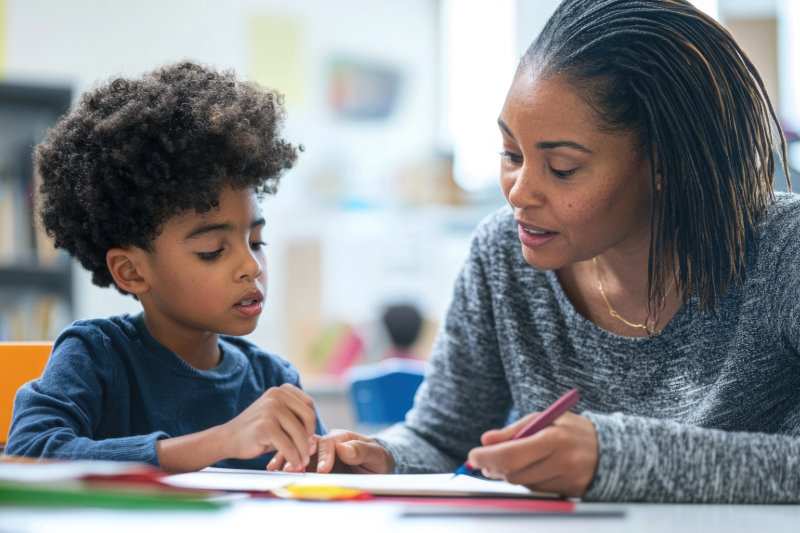Research Spotlight: Leigh McLean

CEHD associate research professor shares new tool and findings on emotional transmission in the classroom
Elementary school teachers often play a special role in their students’ lives, wiping away their kindergarteners’ tears when they’re missing their parents or supporting their fourth graders through a frustrating math lesson. It’s easy to imagine how a child’s emotions may evoke feelings of joy or empathy in a teacher, but how might a teacher’s emotions affect a child’s learning?
In a new article published in Contemporary Educational Psychology, University of Delaware Associate Research Professor Leigh McLean offers a new tool for measuring teachers’ emotional expressions and studying how these expressions affect their students’ attitudes toward learning. With co-author Nathan Jones of Boston University, McLean uses this tool to gather new data showing emotional transmission between teachers and their students in fourth-grade classrooms.
In their study, they found that teachers displayed far more positive emotions than negative ones. But they also found that some teachers showed high levels of negative emotions. In these cases, teachers’ expressions of negative emotions were associated with reduced student enjoyment of learning and engagement. These findings add to a compelling body of research highlighting the importance of teachers’ and students’ emotional experiences within the context of teaching and learning.
“Anyone who has been in a classroom knows that it is an inherently emotional environment, but we still don’t fully understand exactly how emotions, and especially the teachers’ emotions, work to either support or detract from students’ learning,” said McLean, who studies teachers’ emotions and well-being in the College of Education and Human Development’s School of Education (SOE) and Center Research in Education and Social Policy (CRESP). “This new tool, and these findings, help us understand these processes more precisely and point to how we might provide emotion-centered classroom supports.”
Measuring teacher and student emotions
McLean and Jones collected survey data and video-recorded classroom observations from 65 fourth-grade teachers and 805 students in a Southwestern U.S. state. The surveys asked participants to report their emotions and emotion-related experiences—like feelings of enjoyment, worry or boredom—as well as their teaching and learning behaviors in mathematics and English language arts (ELA).
Using the new observational tool they developed—the Teacher Affect Coding System—McLean and Jones also assessed teachers’ vocal tones, body posturing, body movements and facial expressions during classroom instruction and categorized outward displays of emotion as positive, negative or neutral. For example, higher-pitched or lilting vocal tones were categorized as positive, while noticeably harsh or sad vocal tones were categorized as negative.
Overall, McLean and Jones found that teachers spent most of their instructional time displaying outward positive emotions. Interestingly though, they did not find any associations between these positive emotions and students’ content-related emotions or learning attitudes in ELA or math.
“This lack of association might be because outward positivity is the relative ‘norm’ for elementary school teachers, and our data seem to support that,” McLean said. “That’s not to say that teachers’ positivity isn’t important, though. Decades of research has shown us that when teachers are warm, responsive and supportive, and when they foster positive relationships with their students, students do better in almost every way. It could be that positivity works best when done in tandem with other important teacher behaviors or routines, or it could be that it is more relevant for different student outcomes.”
However, they did find that a small subset of teachers—about 10%—displayed notable amounts of negative emotions, with some showing negativity during as much as 80% of their instructional time. The students of these teachers reported reduced enjoyment and engagement in their ELA classes and reduced engagement in their math classes.
“We think that these teachers are struggling with their real-time emotion regulation skills,” McLean said. “Any teacher, even a very positive one, will tell you that managing a classroom of students is challenging, and staying positive through the frustrating times takes a lot of emotional regulation. Emotion regulation is a particularly important skill for teachers because children inherently look to the social cues of adults in their immediate environment to gauge their level of safety and comfort. When a teacher is dysregulated, their students pick up on this in ways that can detract from learning.”
Recommendations for supporting teacher well-being
Given the findings of their study, McLean and Jones make several recommendations for teacher preparation and professional learning programs. As a first step, they recommend that teacher preparation and professional learning programs share information about how negative emotions and experiences are a normal part of the teaching experience. As McLean said, “It’s okay to be frustrated!”
However, it is also important to be aware that repeated outward displays of negative emotion can impact students. McLean and Jones also suggest that these programs provide specific training to teachers on skills such as mindfulness and emotion regulation to help teachers manage negative emotions while they’re teaching.
“Logically, these findings and recommendations make complete sense,” said Steve Amendum, professor and director of CEHD’s SOE, which offers a K-8 teacher education program. “After working with many, many teachers, I often see teachers’ enthusiasm or dislike for a particular activity or content area transfer to their students.”
McLean and Jones, however, are careful to emphasize that supporting teacher well-being can’t just be up to the teachers. Assistant principals, principals and other educational leaders should prioritize teacher wellness across the school and district. If teachers’ negative emotions in the classroom result in part from challenging working conditions or insufficient resources, educational leaders and policymakers should consider system-wide changes and supports to foster teacher well-being.
To learn more about CEHD research in social and emotional development, visit its research page.
Article by Jessica Henderson. Image by Adobe Stock.

About Leigh McLean
Leigh McLean is an associate research professor in CEHD’s SOE and CRESP. She investigates how teachers’ emotions, emotion-related experiences and well-being impact their effectiveness. She is particularly interested in how teachers’ emotions impact their instructional practices and the role that early-career teachers’ emotions play as they transition into the field. She holds expertise in quantitative, mixed-methods and longitudinal study design and implementation as well as multileveled data analysis and classroom observation.
This research complements the work of College of Education and Human Development (CEHD) faculty studying social and emotional development, including Ann M. Aviles, Tia Barnes, George Bear (emeritus), Roderick L. Carey, Sarah Curtiss, Nicole W. Garrity, Marika Ginsburg-Block, Sara Goldstein, Eric K. Layland, Teomara Rutherford, Kristin Scardamalia and Brittany Zakszeski.



